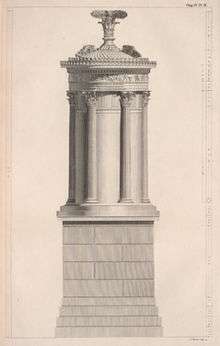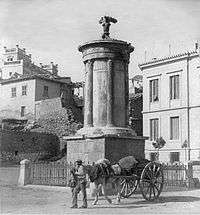Choragic Monument of Lysicrates


The Choragic Monument of Lysicrates near the Acropolis of Athens was erected by the choregos Lysicrates, a wealthy patron of musical performances in the Theater of Dionysus, to commemorate the award of first prize in 335/334 BCE to one of the performances he had sponsored. The choregos was the sponsor who paid for and supervised the training of the dramatic dance-chorus.
The monument is known as the first use of the Corinthian order on the exterior of a building. It has been reproduced widely in modern monuments and building elements.
History
The circular structure, raised on a high squared podium, is the first Greek monument built in the Corinthian order on its exterior. It was originally crowned with an elaborate floral support for the bronze tripod that was the prize Lysicrates' chorus won. Its frieze sculptures depict episodes from the myth of Dionysus, the god whose rites developed into Greek theatre.[1] It stands now in its little garden on the Tripodon Street ("Street of the Tripods"), which follows the line of the ancient street of the name, which led to the Theater of Dionysus and was once lined with choragic monuments, of which foundations were discovered in excavations during the 1980s.

In 1658, a French Capuchin monastery was founded by the site; in 1669 the monastery succeeded in purchasing the monument, then being called the "Lantern of Demosthenes".[2] It was also called "Lantern of Diogenes". A reading of its inscription by Jacob Spon established its original purpose.[3] The young British architects James "Athenian" Stuart and Nicholas Revett published the first measured drawings of the monument in their Antiquities of Athens, London 1762. The monument became famous in France and England through engravings of it, and "improved" versions became eye-catching features in several English landscape gardens. Lord Byron stayed at the monastery during his second visit to Greece. In 1818, friar Francis planted in its gardens the first tomato plants in Greece. In 1821 the convent, which had enclosed the monument, used as a storage for books, was burned during the Ottoman occupation of Athens, and subsequently demolished, and the monument was inadvertently exposed to the weather.[4] In 1829, the monks offered the structure to an Englishman on tour, but it proved to be too cumbersome to disassemble and ship. Lord Elgin negotiated unsuccessfully for the monument, by then an icon in the Greek Revival.
French archaeologists cleared the rubble from the half-buried monument and searched the area for missing architectural parts. In 1876–1887, the architects François Boulanger and E. Loviot supervised a restoration under the auspices of the French government.
Other versions

Famous British versions of the Choragic Monument include the Dugald Stewart Monument and Burns' Monument both on Calton Hill in Edinburgh, on the tower of St Giles Church in Elgin and in the gardens at Shugborough, Staffordshire and Alton Towers among many others. The Grade I-listed St John the Evangelist's Church, Chichester, now redundant, is topped with a "preposterous miniature" of the monument.[5][6]
In the US, the Choragic Monument was William Strickland's model for the cupola of the Merchants' Exchange in Philadelphia and copied by him for the cupola atop the Tennessee State Capitol building in Nashville.[7] The design of the Portland Breakwater Light in Maine was inspired by the monument. It was adapted for Civil War memorials and capped many Beaux-Arts towers, such as The San Remo's towers in New York. The most prominent example is the Soldiers' and Sailors' Monument designed by architects Charles and Arthur Stoughton and erected on Riverside Drive in New York City in 1902. A bronze miniature of the Choragic Monument is handed out for the Richard H. Driehaus Prize recognizing a living architect whose work exemplifies the values of traditional and classical architecture in a contemporary built environment.[8]
In Australia, there is a version in the Royal Botanic Gardens, Sydney in New South Wales. It is also reproduced at the Shrine of Remembrance in Melbourne where it forms a crowning element at the top of the memorial's pyramid-like roof.
Other Information
On June, 2016, Anarchists vandalised the monument with spray paint, writing: ´Your Greek monuments are concentration camps for "immigrants" (refugees)´.[9]
References
- ↑ Herbert F. De Cou, "The Frieze of the Choragic Monument of Lysikrates at Athens", The American Journal of Archaeology and of the History of the Fine Arts, 8. 1 (January - March 1893):42-55) summarizes the history
- ↑ J. R. McCredie, "The 'Lantern of Demosthenes' and Lysikrates, son of Lysitheides, of Kikynna," in Studies Presented to Sterling Dow (GRBS Monograph 10), 1984:181-183.
- ↑ Spon, Voyage d'Italie, de Dalmatie, de Grèce et du Levant, (1678) vol. III, pt 2 pp21ff (noted in Cou 1893)..
- ↑ Cou 1893.
- ↑ Nairn, Ian; Pevsner, Nikolaus (1965). The Buildings of England: Sussex. Harmondsworth: Penguin Books. p. 170. ISBN 0-14-071028-0.
- ↑ Salzman, L. F. (ed) (1935). "A History of the County of Sussex: Volume 3. The City of Chichester: Churches (Anglican)". Victoria County History of Sussex. British History Online. pp. 160–164. Retrieved 29 April 2011.
- ↑ "Cupolas of Capitalism Picture Gallery"
- ↑ NDUA: Choragic Monument, bronze miniature for Driehaus Prize
- ↑ "Βανδάλισαν με σπρέι το άγαλμα του Λυσικράτη". thepressroom.
External links
| Wikimedia Commons has media related to Choragic Monument of Lysicrates. |
- Excerpts from guidebooks
- American Beaux-Arts uses of the Choragic Monument
- "Neoclassic architecture and the influence of Antiquity"
Coordinates: 37°58′15″N 23°43′48″E / 37.97083°N 23.73000°E